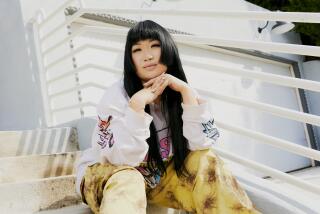Go ahead, layer it on
- Share via
The rules for wearing denim with denim are about to be broken. Though it was a major no-no in the 1990s (think Britney Spears and Justin Timberlake in their bedazzled denim ensembles complete with denim hats and accessories), today the combination of jeans with a chambray shirt or a denim vest is not only acceptable, it’s current.
Celebrity stylist Nicole Chavez recently wore a light-colored chambray button-down shirt with a pair of medium-blue skinny jeans and Celine’s tan wedge clogs to brunch at the Soho House, a sure sign that denim on denim really works. “It’s a fresh twist on a classic,” says Chavez, whose client Rachel Bilson has also been known to sport a few layers of denim. “It’s been such a faux pas since the early ‘90s, so now it feels like a rebellious and modern way to wear” it.
The denim on denim look is very much part of this season’s “work wear” styles such as overalls, button-down shirts and vests and patchwork detail on jeans, and the use of washes that add a slight variance in color as well as texture to the fabric, providing a distressed, almost vintage look.
Walk into any number of stores and you might see jeans that look as though they’ve been worn every day for the last five years, with abrasions on the thighs and seats, and denim vests with frayed arm holes that appear to be the result of someone ripping the sleeves off a jacket whose owner has endured a long day of manual labor outdoors. In a way, wearing denim has gone back to basics, when people wore the sturdy fabric for practical purposes and an all-blue outfit wasn’t a bad thing.
There are scores of possibilities when it comes to washing and treating denim. And much of that processing happens in Southern California.
Jerome Dahan, founder of Citizens of Humanity and one of the denim industry’s most seasoned veterans (he’s been connected to Guess, Lucky Brand, Circa, and 7 for all Mankind at one time or another) is wash-obsessed, testing, creating and formulating new ideas like a mad scientist. He owns the CM Wash House in Gardena, where Citizens of Humanity and his business partner Adriano Goldschmied’s line Goldsign jeans are washed, sandblasted, baked and treated.
“For the past 10 years, L.A has been the place where everybody from all over the world comes to wash their denim,” Dahan says. He cites Japan and Italy as the other denim washing and processing capitals, but names L.A. as the center of washing denim in America. “People from Europe and Japan are coming here to wash and do some sewing. They know the quality is here as well as the price point. Denim comes from America -- think Levis, Wrangler, Lee. You’ve got to come back to where it all started.”
Thirty thousand pairs of jeans -- arriving in their raw, stiff, indigo state -- come through Dahan’s wash house each week. The process depends on the design of the garment. “Every season there are between 40 to 50 different washing processes,” says Dahan, who incorporates dyes and chemicals in the wash process, but also uses pumice stones, twist ties and machinery to get the right whiskering and abrasion on each pair of jeans. “It’s like today you make a pasta, tomorrow you make a risotto and the day after that, maybe make a roast chicken. It’s like food to me, because to cook a good meal it takes time. You add different ingredients to get different results.”
The various “ingredients” and steps in the wash process can be extremely involved. For example, jeans designed to have gathering around the upper thigh are put onto 3-D forms, hand-gathered and starched before being baked with resin to seal the effect into place. You know those lighter areas on the thighs and seat of your jeans? Those are hand-sanded by employees who stand under a pair of jeans pulled onto a suspended 3-D form, keeping at it until the abrasion and lightness are perfected. None of this happens by accident. Every treatment, knick, pleat, hole and gather has been formulated specifically with the end result in mind and the sometimes complicated process is a good part of the reason denim prices can climb past $300.
This season’s looks are more subtle than in seasons past -- think tie-dye and ‘80s-style bleaching, or over-dying and color saturation -- thus, the possibility of denim on denim.
But stylists warn that garments should have at least a variance in color, while staying in the same family of blue or doing faded black with blue or railroad stripe with chambray shirts. “I think the most modern way to rock the look is with a chambray button-down and jeans that are a shade darker or lighter,” Chavez says. “Anything too matchy-matchy is never a good thing.”






